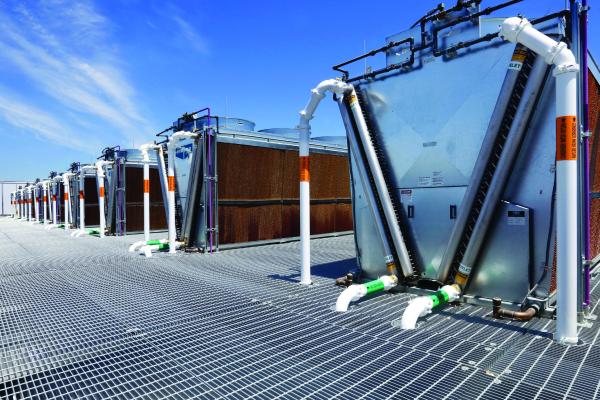Technology
This article will explore the Cooling Technologies Institute (CTI) Standard 201 (STD-201) Thermal Certification This article will explore the Cooling Technology Institute (CTI) Standard 201 (STD-201) Thermal Certification Program, share perspective from leading cooling tower manufacturers, and cover other existing and evolving CTI test codes, standards and certifications. This article will also emphasize the investment and bandwidth contributed to CTI by cooling tower manufacturers for the benefit of the industry and its end users.
The 2023 AHR Expo co-sponsored by ASHRAE and AHRI was held Feb. 6-9 at the Georgia World Congress Center in Atlanta, GA. A total of 1,779 exhibitors (425 international) spread across 487,000 square feet, and several dozen free educational sessions drew 42,794 total attendees. HVACR equipment manufacturers and suppliers displayed their latest innovations engineered to address the megatrends in the HVACR industry and market. This report will highlight the cooling tower, chiller/heat pump and associated technology innovation centered around electrification, decarbonization and water conservation.
[ Read Full Story ]
The mission of CTI is to advocate and promote the use of all environmentally responsible commercial cooling technologies. Three committees make up CTI’s primary working groups - Engineering, Standards & Maintenance (ESM); Performance & Technology (P&T); and Water Treatment (WT). The conference featured over 35 presentations by recently published technical paper authors from the industry.
[ Read Full Story ]
This article will explore why tanks are used in cooling systems, why they might not be used in cooling systems, and finally considerations to be evaluated in determining if tanks are needed in any particular central plant cooling system. Part 2 will review specific application details for using tanks and also for tankless systems and system conversions.
[ Read Full Story ]
Chiller & Cooling Best Practices Magazine interviewed Glenn Brenneke, Vice President of Engineering and R&D, SPX Cooling Technologies, to discuss the Marley 100-year anniversary.
[ Read Full Story ]
The Sterling Heights facility, producing jet engines for the U.S. Army, has undergone extensive overhauls and re-tooling in the last decade. In 2010, Stellantis announced it would invest nearly $850 million in a new state-of-the-art paint shop at the SHAP Site, as well as the installation of new machinery, tooling and material-handling equipment. The following year, the company added another $165 million to the investment to build a one million-square-foot body shop.
[ Read Full Story ]
An Illinois food service products manufacturer now saves nearly 60% of their base annual cooling energy costs through improvements made in three phases over several years. The plant, which has a 1200 ton chilled water plant, implemented upgrades including pump and tower fan VFDs and enhanced function controls, free cooling, and chiller compressor drive retrofits. The revisions built through successive phases to capture further benefits from more complete utilization of the preceding steps’ capabilities.
[ Read Full Story ]
The electrification of heating presents a significant opportunity to achieve decarbonization goals by reducing or eliminating the use of fossil fuels in traditional building systems such as boilers. The current geopolitical scenario has caused commodity prices to quickly rise and forced businesses, cities and countries to rethink their future dependance on fossil fuels and accelerate the conversion to sustainable alternatives.
[ Read Full Story ]
In June 1920, Willis Haviland Carrier prepared a memo that described a novel machine and refrigerant that might significantly advance the art and science of air conditioning.
Already celebrated for his 1911 “Rational Psychrometric Formulae,” Carrier imagined a “centrifugal chiller” and new refrigerant that would not only enhance process cooling in factories around the world, but reliably and affordably deliver “comfort air” to the public in theaters, stores, restaurants, sports venues, ships, hospitals and office buildings.
[ Read Full Story ]
The 2022 AHR Expo co-sponsored by ASHRAE and AHRI was held Jan. 31 – Feb. 2, at the Las Vegas Convention Center. A total of 1,573 exhibitors (281 international) spread out over 440,000 square-feet, and 80 free sessions in the Education Program drew more than 30,000 attendees to the event. Common trends discussed amongst exhibitors focused on energy efficiency, operational reliability, connectivity and new chiller refrigerant transitions spurred by approaching regulatory transition dates in the AIM Act enacted by US Congress in late 2020.
[ Read Full Story ]
Like many universities across America, The University of Cincinnati had a major challenge having to operate aging central utility plants with older technology, reduced efficiencies and capacities, with chilled water equipment at the end of its service life. Even so, UC needed to maintain plant operations under diverse load conditions, including critical hospital utility demands that are currently expanding and in daily periods subject to energy tariff.
[ Read Full Story ]

